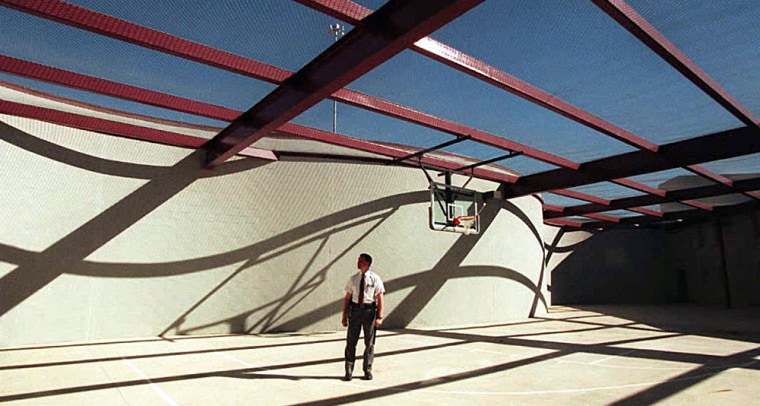It's not the death penalty, but convicted al-Qaeda conspirator Zacarias Moussaoui will soon face a punishment that some consider even worse: up to 23 hours a day in a soundproof, concrete cell, cut off from contact with anyone other than his guards and, perhaps, the lawyers who helped save him from execution.
Moussaoui is expected to be transferred within days to the Administrative Maximum United States Penitentiary, or Admax, in Florence, Colo., the federal government's most secure prison, located in the high desert 90 miles south of Denver.
Dubbed the "Alcatraz of the Rockies" by prison experts -- and "The Tombs" by many prisoners and their lawyers -- the 12-year-old "supermax" facility houses about 400 of the most dangerous and infamous prisoners in the federal system, from "Unabomber" Theodore J. Kaczynski to Ramzi Yousef, architect of the 1993 World Trade center bombing. After the Sept. 11, 2001, attacks, the U.S. Bureau of Prisons transferred most, if not all, of its terrorism-related inmates to the prison.
But Moussaoui is unlikely to meet, or even glimpse, Yousef or any other fellow jihadists at the Florence facility anytime soon, according to federal officials, lawyers and others familiar with operations there.
In the most tightly monitored part of the facility, known as the "control unit," inmates are kept in segregation at all times -- living, sleeping and eating in individual cells poured from concrete that measure approximately 7 feet by 11 feet. They are designed to ensure that inmates cannot speak or make eye contact with each other, according to defense lawyers, human rights advocates and others who have had access to the facility. Some prisoners are monitored 24 hours a day by surveillance cameras in their cells, as Moussaoui has been during his years in the Alexandria jail.
Most of the facility's cells are outfitted with small black-and-white televisions with a limited number of channels. It is unclear whether Moussaoui will be allowed to watch one.
Some inmates are allowed a handful of visitors and phone calls each month, but many of those incarcerated for terrorism-related crimes have no visitors other than their attorneys and the guards who shackle them whenever they are removed from their cells, according to defense attorneys and court testimony.
High-tech solitary confinement
"It's a modern-day, high-tech form of solitary confinement," said Jamie Fellner, head of Human Rights Watch's U.S. program, who spent two days touring the Florence facility as part of a study on supermax prisons. "It's not the dungeon of old. There are lights and it's clean. But it's still not humane. Conditions that may be justifiable for three months become much more problematic when it becomes three years or longer."
The prison includes several general population units where inmates are given much greater freedom, including communal dining, as part of a program to move former troublemakers back into regular penitentiaries. But many defense attorneys for inmates convicted on terrorism charges say the harshest restrictions have not been lifted for their clients, who are often subject to special administrative measures, or SAMs, ordered by the attorney general.
Bernard V. Kleinman, a New York lawyer who represents Yousef, said he is the only person allowed to visit his client. He said Yousef often spends days at a time without leaving his cell, declining an hour of solitary exercise time because of body-cavity searches performed before and after each session.
"Anybody who thinks the death penalty was more punishment than this doesn't know what it's like to live completely alone for the rest of your life," Kleinman said. "If they really wanted to punish him, the death penalty might have made sense politically, but spending the rest of his life in the [Admax] is about the worst you could do to him."
The roster at Florence reads like a who's who of domestic terrorists and captured al-Qaeda operatives.
In addition to Yousef and Kaczynski, there is Oklahoma City bombing conspirator Terry L. Nichols; failed shoe bomber Richard C. Reid; Atlanta Olympics bomber Eric Rudolph; and Wadih el-Hage, convicted of conspiracy in connection with the 1998 U.S. embassy bombings in East Africa. The facility also includes lesser-known terrorists, violent gang leaders and spies, from Japanese Red Army member Yu Kikumura to Robert P. Hanssen, the former FBI agent and Soviet mole.
"Our most dangerous, disruptive and escape-prone inmates are housed there, as well as others with security concerns," said Traci Billingsley, a U.S. Bureau of Prisons spokeswoman. "We have to take whatever precautions are necessary to ensure the safety of corrections officers and the general public."
Billingsley said that Moussaoui, who was sentenced to life in prison yesterday morning, had not been formally assigned to a prison. But numerous officials said Moussaoui is certain to be sent to Florence because of its designation as the facility for convicted terrorists and because it is the only "supermaximum" facility in the federal system.
Transfer likely in a few weeks
Moussaoui is likely to be transferred within a few weeks, Billingsley said, but for security reasons the move will not be disclosed until after it occurs.
Moussaoui, who was prone to courtroom outbursts, has been living under extremely tight security since shortly after he was charged in December 2001 with conspiring in the Sept. 11 attacks. Held in solitary confinement at the Alexandria jail, Moussaoui was closely monitored and restricted in his contacts and the materials allowed in his cell.
Alexandria Sheriff Dana Lawhorne declined to discuss the specifics of Moussaoui's confinement in that city's jail, but said that "it was a very restrictive, monitored environment."
"Am I glad to see him go? I think that it's time," Lawhorne said. "It's been a tremendous responsibility that we've taken on . . . I think we'll all be a little relieved to see the day when he's no longer here, it's safe to say."
Researcher Julie Tate contributed to this report.
